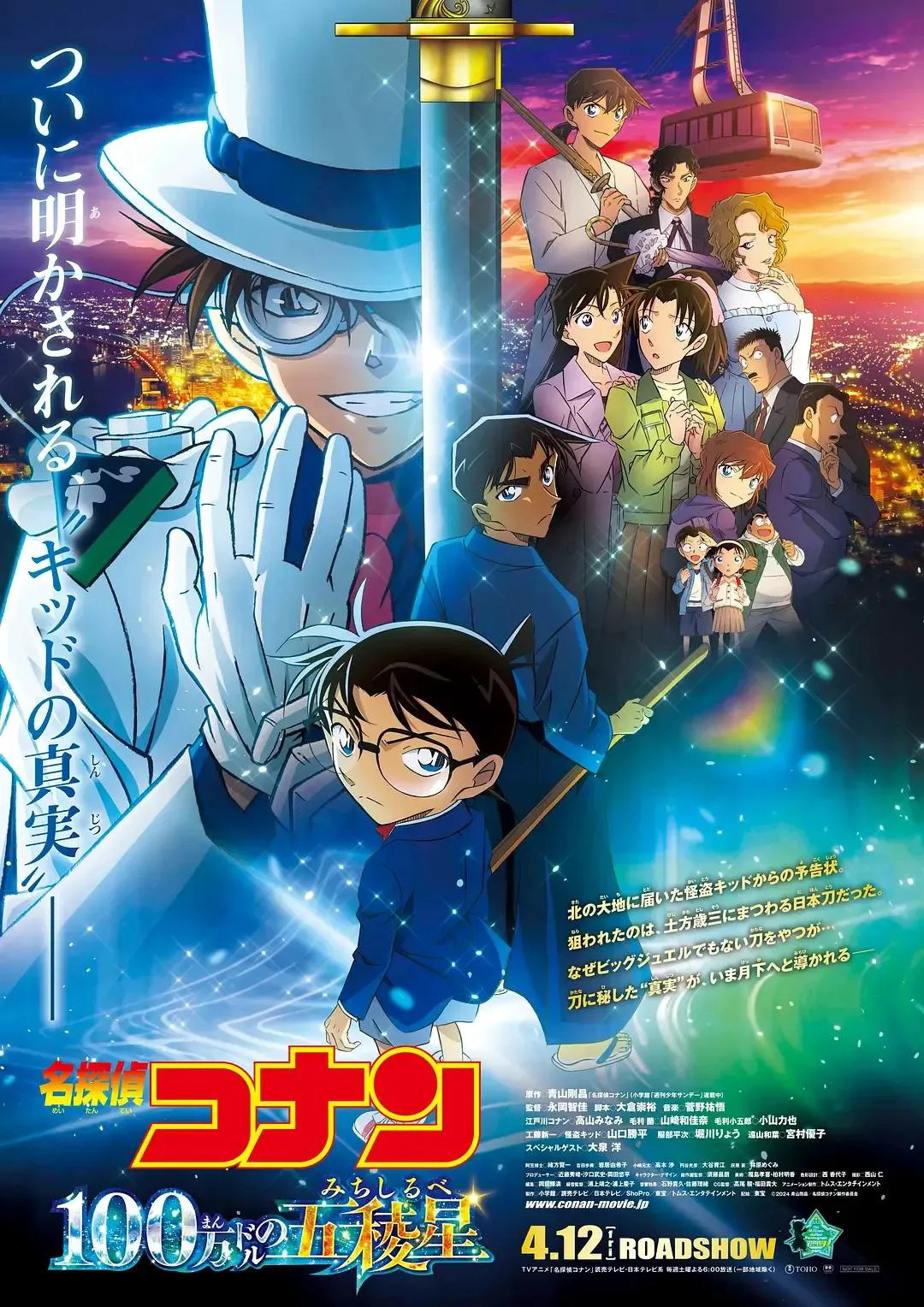As an annual staple of the “Detective Conan” series, the latest film, “Detective Conan: The Million Dollar Pentagram,” has soared to the top of Japan’s 2024 box office charts with a staggering 15.5 billion yen. Its release in mainland China is notably earlier than previous installments, allowing domestic Conan fans to enjoy the official version almost like a “sneak preview.” The film’s release on August 16th even sparked a trending topic on Weibo.
Beyond the highly anticipated question of whether Heiji Hattori will finally confess his feelings to Kazuha Toyama in their ongoing “romantic comedy” subplot, “The Million Dollar Pentagram” also delves into a hidden code involving ancient swords in Hakodate, Hokkaido, uncovering long-buried historical secrets.

A Heist Unlike Any Other
The story begins when the Axe Group’s vault receives a notice from the infamous phantom thief, Kaito Kid.
However, this time, Kid’s target isn’t a priceless gem, but a precious Japanese sword once owned by Toshizo Hijikata, the vice-commander of the Shinsengumi during the Edo period. Why would Kid, typically interested in jewels, suddenly be after a sword?
This unprecedented choice sparks curiosity and speculation. Just as Kid is about to make his move, a body with a distinctive cross-shaped wound on its chest is discovered in Hakodate’s warehouse district, disrupting the planned “theft.” Hakodate’s annual kendo tournament is set to become a mysterious and treacherous competition.
The Swords and the Secrets
The murder introduces Brian D. Neeson, a Japanese-American arms dealer known as the “Merchant of Death.” He’s been searching for a treasure hidden in Hakodate by the first head of the Axe family, rumored to be a powerful weapon capable of turning the tide of the Bakumatsu era. This treasure is inextricably linked to the sword Kid is after, which seems to hold the key to unlocking its secrets.
“The Million Dollar Pentagram” dedicates a significant portion of its narrative to the ancient sword Kid seeks to steal. It not only unveils a secret from the Edo period but also becomes crucial to the unfolding story due to its embodiment of the essence of Japanese swordsmanship and Feng Shui culture.
Previous “Detective Conan” films have also incorporated elements of Japanese culture. For example, the core case in “The Crimson Love Letter” is closely tied to “karuta,” a traditional Japanese card game.
Karuta: A Game of Wits and Poetry
Karuta, also known as “Ogura Hyakunin Isshu,” is a card game where players must quickly find the matching lower verse of a waka poem as the reader recites the upper verse. The game tests participants’ intelligence and reflexes while embodying the beauty and essence of Japanese poetry.
In “The Crimson Love Letter,” Conan and Heiji become entangled in a complex case related to karuta. As they investigate, they discover that karuta is not just a game but a crucial clue to solving the mystery. Each card becomes a puzzle that requires their wit and deduction to unravel. From the selection of cards and the rules of the game to the participants’ words and actions, everything becomes an important piece of their reasoning.
A Battle of Wits and Swords
Returning to “The Million Dollar Pentagram,” the complex case revolving around the Japanese sword and the treasure shares similarities with the atmosphere of the kendo tournament, where various factions engage in overt and covert struggles, showcasing a blend of intelligence and strategy.
Conan and his team begin their investigation with the murder victim, discovering that he was a consultant lawyer for the Axe Group. His last task was to bring two Japanese swords forged by Toshizo Hijikata into the country to help Axe Takuzo, the heir to the Axe Group, acquire the treasure.
On the other side, the arms dealer Neeson, who has long coveted the treasure, is willing to threaten the entire city with explosions to achieve his goals, pushing the event towards a “last-minute rescue” scenario.
What is the connection between the Fukushiro family, who specialize in Iaijutsu swordsmanship, and the ancient swords and treasure that Conan, Heiji, and Kid are pursuing and confronting?
These power struggles progressively become “hooks” that captivate the audience.
Unraveling the Code
The treasure itself, described as something that could overturn wars and rewrite history, is enough to spark endless desire and imagination in both the characters and the audience.
Neeson and Axe Takuzo may be drawn to the treasure’s wealth, seeing it as a key to fulfilling their personal desires. But behind this, there may be deeper motivations such as power and status.
For others, what the treasure actually is may not be the most important thing. It’s more like a trigger, a prop used to shape the characters and bring out their greed, desire, courage, wisdom, and choices. These choices are the starting point for the conflicts between different factions.
The Dynamic Duo
In this film, the spotlight shines on the chivalrous thief Kaito Kid and the brilliant detective from the West, Heiji Hattori. In addition to the main mystery plot, the director also leaves “punctuation marks” for the audience to enjoy their interactions.
The film opens with a kendo duel between Kaito Kid and Heiji Hattori under the moonlight, not only giving Heiji some long-awaited excellent close-ups but also revealing the biggest highlight from the one-and-a-half-minute trailer – Heiji sees Kid’s true face, putting an end to the controversy of “Conan and Kid sharing the same face.”
The ending doesn’t forget to include Kazuha and Heiji’s confession scene. How many buffs can Hakodate Mountain, known for its “million-dollar night view,” add to their confession?
Whether “The Million Dollar Pentagram” can revitalize the “Detective Conan” IP in China remains to be seen, and the answer will be revealed through the ever-changing box office data and the final audience reviews. Regardless of the outcome, the “Conan” series continues to offer viewers an endlessly imaginative and ongoing story.